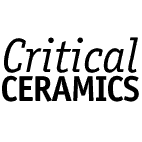









simple clarity modest depth bold complex
These words can be paired as opposites. They can be used to describe people, concepts, the products of people�s concepts.
I find myself drawn to things that are a synthesis of seemingly dichotomous terms � Agnes Martin�s simple paintings and writings which make one aware of life�s complexities, Isamu Noguchi's sculptures with their modest forms and humble materials that are bold in size and placement, the nature of water which disguises its true depth by its transparent clarity.
Clay has many dualities. It is primitive - advanced, malleable - hard, smooth - rough, flat - dimensional. It has a rich, long history particularly in Japan, however, the first nonfunctional ceramic art objects appeared only a few decades ago.
Postwar Japan is intriguing. Traces of the past exist in traditions, architecture, aesthetics. Wabi - sabi, tea, and Zen quickly define traditional Japanese aesthetics, yet the so called Westernization of Japan created a culture based on a dual nature. Throughout In Praise of Shadows, Tanizaki comments on the clashing aesthetic sensibilities between Japan and the West. Today, Japan blends its old tastes with its newer adoptions.
At times, this mixture is tense, at others it is harmonious. In Japan, I wish to explore the dynamics between old and new through art, specifically ceramic art. If awarded a Fulbright, I will spend five to six months with ceramicist Eiji Kinoshita in Oita, Kyushu.
Kinoshita apprenticed with Master potter Hidetaka Ohta. Most ceramicist become independent of their masters later in life, but Kinoshita did so at age 25. He exhibits his work extensively throughout Japan and has show a number of times in the United States as a member of a traditional Japanese artisan group. Two year ago, at the age of 31, Kinoshita was the youngest artist chosen to show at the 41sat Exhibition of Japanese Traditional Arts and Crafts. Recently with aid from his prefecture and the Japanese government, Kinoshita acquired a mountain near his studio. On this mountain a community will be built to provide artists of various mediums the space to work and show their art. Designed to preserve the natural beauty of the environment, construction begins in April 1997.
I wish to work with Kinoshita because of his success in selectively combining and cultivating the old and new. His work and his person reflect contemporary Japan while maintaining a high standard of craftsmanship. While independently utilizing skills passed to him by forefathers from a long tradition, he is interested in ceramics from outside of Japan and is simultaneously eager to introduce Japanese ceramics to others.
In conjunction with working with Kinoshita, another reason I wish to be in Japan is to document the work of ceramic artist Yagi Kazuo. Yagi was a founding member of the Sodeeisha (progressive ceramics) group. In the 1950�s, he revolutionized traditional Japanese ceramics by breaching the codes of pottery and creating nonutilitarian clay objects. He is a very important figure in Japanese ceramic history, yet few Americans know little about him. Material concerning Yagi is scarce. The Bernard Leach - Shoji Hamada tradition of pottery is well known in the United States. As their contemporary and counterpart, I believe it is vital for a figure such as Yagi to be more accessible to Americans. Just as there exists the functional and nonfunctional duality in ceramics, there is Hamada and Yagi. In the United States today, the balance is still heavily weighted by Hamada.
A physician who resides in Nakano, Tokyo, Dr. Maie was personal friends with Yagi. Today, he has one of the largest Yagi collections in Japan. As a potter and assistant to Dr. Maie, Yuko Tenma manages Dr. Maie's estate and art collection in Ibaraki. She maintains a studio there as well. I first began ceramics under the instruction of Tenma using Shigaraki clay. As a woman potter, which is still rare at this time, Tenma apprenticed in the Tanba tradition. Through her, I learned how to throw and form shapes Japanese style. The first kiln I fired was an anagama kiln built by the master Shigaraki potter Michiyo Furutani.
While learning to respect tradition, Dr. Maie and Tenma exposed me to the works of Yagi and his nontraditional tendencies. I have been fortunate with my encounters and wish to share them. While working on my own art in Oita, I plan to regularly correspond with Dr. Maie and Tenma. After completing a substantial body of work and showing at a gallery, I would like to spend three months working to collect data with Dr. Maie and Tenma on Yagi; Dr. Maie for his accounts of Yagi as a person and artist and Tenma for documentation of his works. As I pursue this, Tenma's studio will provide a place for me to continue making my own work as well.
This will hopefully lead to an eventual English publication on Yagi. While I am not an art historian nor an authority on Japanese ceramics, I do have access to people in the respective fields. With their collaboration and that of a large publisher such as Kodansha International, information on Yagi will hopefully be available to a wider audience in the United States.
I have been fortunate to study at Alfred and in the future, wish to attend graduate school. Before applying myself to this commitment, I feel it necessary to pursue my work outside of an institution. This will strengthen my personal vision and prepare me for serious graduate work. While in Japan, I hope to begin such preparations.
Presently, my work attempts to merge dualities. My bicultural background has shaped this. I am Japanese. I am American. Japan and America are different. Art is a means of expression and communication. Visually, emotionally, and through tactile senses, I wish to express opposites and differences not as judgmental determinations such as good versus bad or better versus worse, but merely as differences. I try to juxtapose differences and let them quietly coexist. Will this help people be more accepting of differences? Of different values, different opinions, different tastes? I do not know. My hope is that it will.
The planned date for departure is September 1, 1997 for one academic year.




